Story – Christopher Hector Photos – Roslyn Neave
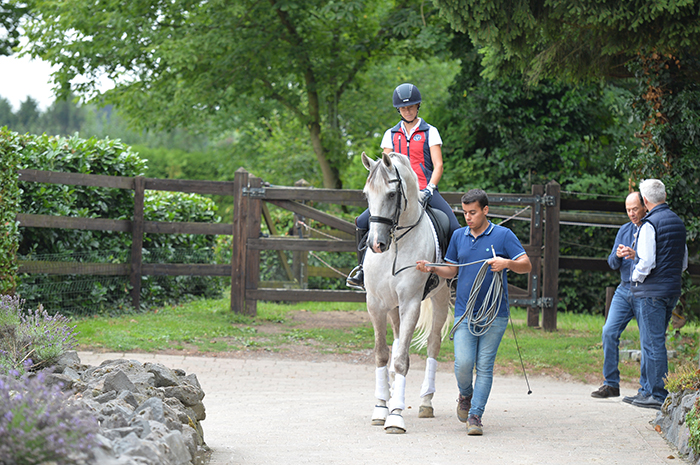
Ton de Ridder – A lesson with Maria Caetano Couceiro and Biso Des Lezirias
Portuguese dressage star, Maria Caetano Couceiro is one of my favorite riders, trained by her famous bull-fighter father, Paulo, she is quiet, classical and effective. Even though she rides unfashionable Lusitanos, she has forced her way into the top fifty world dressage rider rankings, consistently scoring 70 at major competitions, like Aachen. For the past twelve months she has had added help in the form of Ton de Ridder – we caught up with Maria and Ton as they had their final workout before Aachen.
The first horse Maria rode was ‘Pinkie’ aka Biso Des Lezirias, an 11-year-old stallion. We saw him 18 months ago competing in the Small Tour at Jerez, since then he has built up and matured. To get to the outdoor, he had to pass a paddock complete with a mare in season, and you see the breed bonus, natural passage.
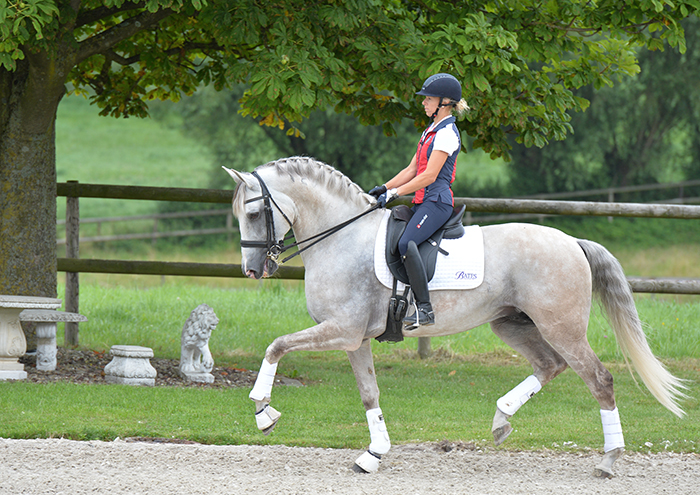
Once down on the arena Ton is working on the frame – “Open the neck. Make it a clear shoulder in, don’t bring the shoulder back too soon, you can even ride it through the corner. Now get him really long and deep.”
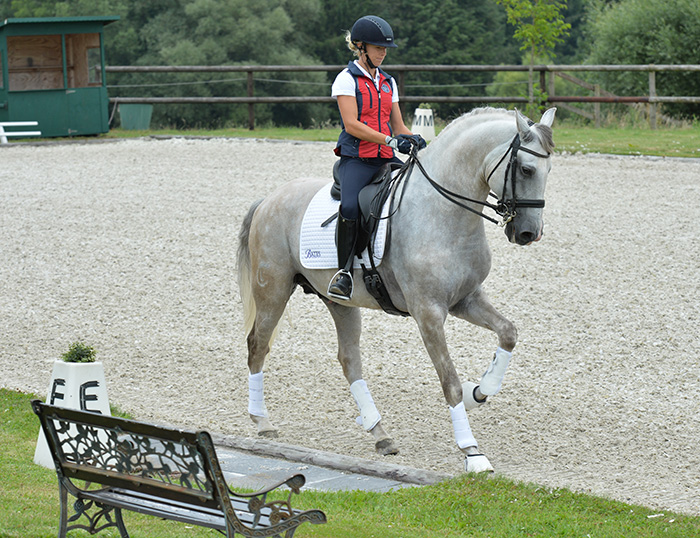
This is fine tuning time, and Ton is ever the technician: “Make the transition more fluid, he stops a little bit with his body. Now half pass, and remember the judge on the centre line sees if it is tricky, or if the horse goes right to the line. Shoulder in before you start the half pass…”
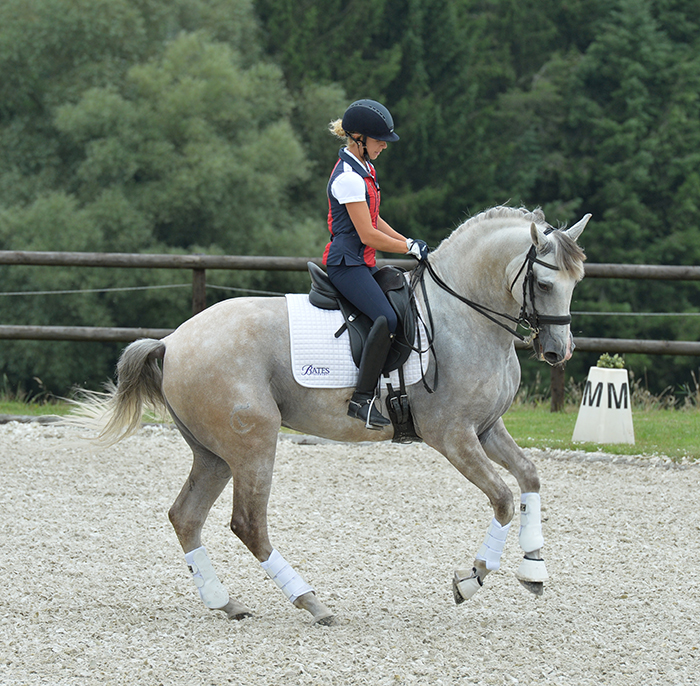
Time to polish the pirouette – “Ride a little forward when you finish, more forward, hands out, don’t sit too heavy. Neck down, out the nose and immediately forward…”
“Now it is time to relax…”
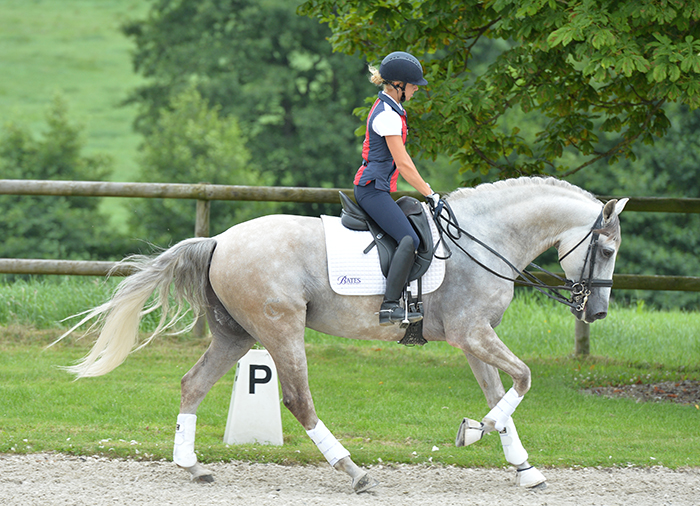
And how did it look at the horse show?
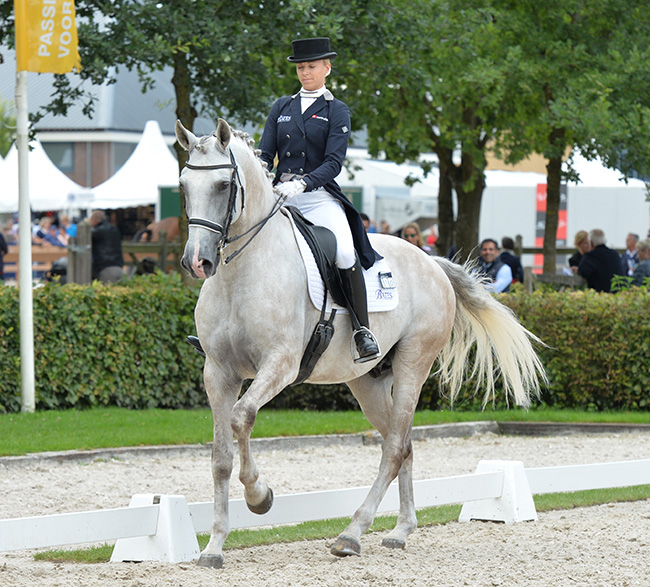
Ton de Ridder: A Life
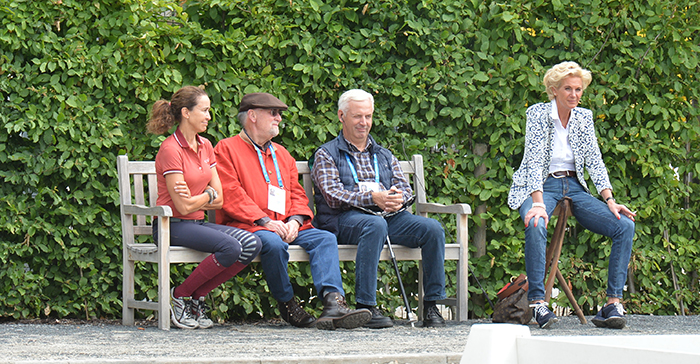
Beatriz Ferrer-Salat, Chris Hector, Ton and Alexandra De Ridder
Ton de Ridder is an interesting guy – for someone who is so quick with the witty response, so finely-tuned to the trend of the action, he is also very happy to stay in the background, quietly polishing his riders and their horses, seamlessly setting them up with the best possible opportunity to compete. So much so, that even though I’ve known Ton for quite a few years and had many conversations with him, I knew nothing about his own equestrian background…
How did you get involved with horses?
“We lived in Holland, in a farming area and a lot of friends of mine came from farming families and they had ponies at home. I liked riding and we started together at the Pony Club – that was the beginning of the disaster.”
Did your family want you to go and having a proper education and a job?
“Absolutely not. I started to study to be a lawyer but I decided I wanted to be with horses. I went to Münster, did my Bereiter examinations with Paul Stecken – one day a week I went to school and the rest of the time I was at Paul Stecken’s stables. After three years you do your examination, so for all three years I was with Paul Stecken.”
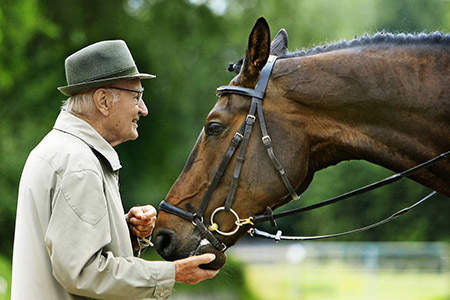
Paul Stecken – the Master (Photo Jacques Toffi)
He was a great teacher…
“He was not only a great teacher but there I really learned to work with young horses – really proper long and deep and working over the back. What he gave to us was really respect for the horse. I think he made a lot of very good professional riders. Udo Lange is one of them and he was there at that time. Still I think about what I learned there, and respect for the horse.”
Case Study 2 – Fenix de Tineo
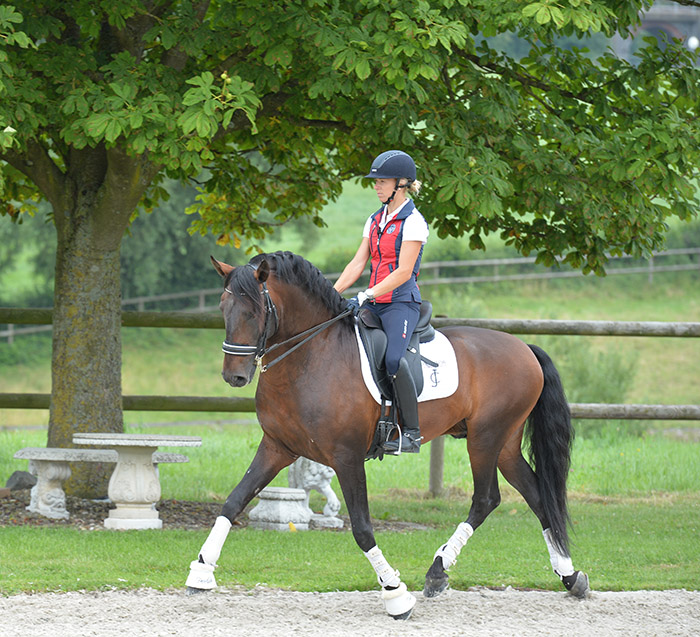
Maria’s next horse to join Ton in the dressage arena, is another stallion, Fenix de Tineo (by Rubi). He is only seven years old, but he already has an international win, in the Inter I at Munich – he too is another natural mover. Once again, it is details, details, details.
In the half pass left: “Look to your left, sit to the left, in the half pass look where you go. Make it clear, finish in shoulder in, don’t stop before the letter.”
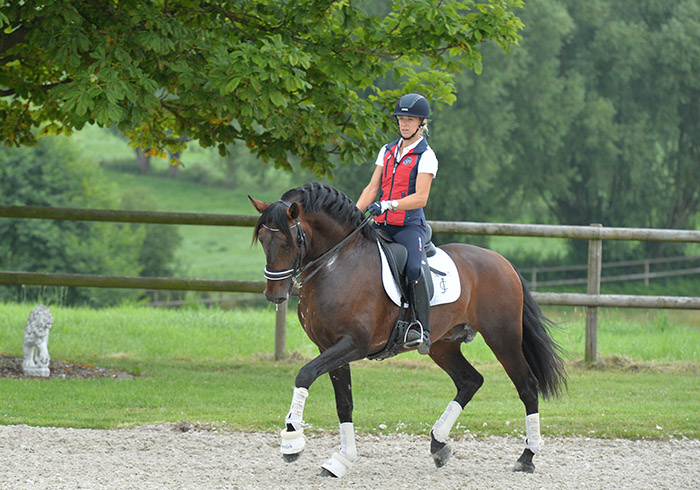
And, “forward your hands, show some lightness, that’s what the judges want to see – not this Dutch riding.”
“In the canter, deeper neck, loose in the back, really jump. Never forget you get points for what they see, not what you feel.”
Once again, the ring-craft: “At Aachen that change in the Prix St Georges is where the horse can look out and see the warm up area, it’s the same in the Grand Prix in the rein back, so you must be thinking ahead.”
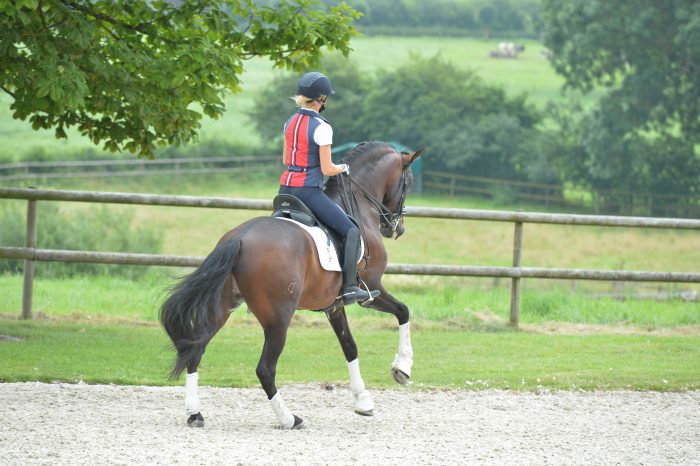
Training is dialogue: “Maria, give me a score for these changes…”
“I started too late.”
“Then you lost the quality of the canter at the end when you collect. Make sure you go right to the marker, show the judges you can control every stride. On the snaffle rein so the horse is uphill in the changes.”
“It is important not to forget the small details, to take the points from the first halt. That was not forward enough, the first impression for the judges must really be forward.”
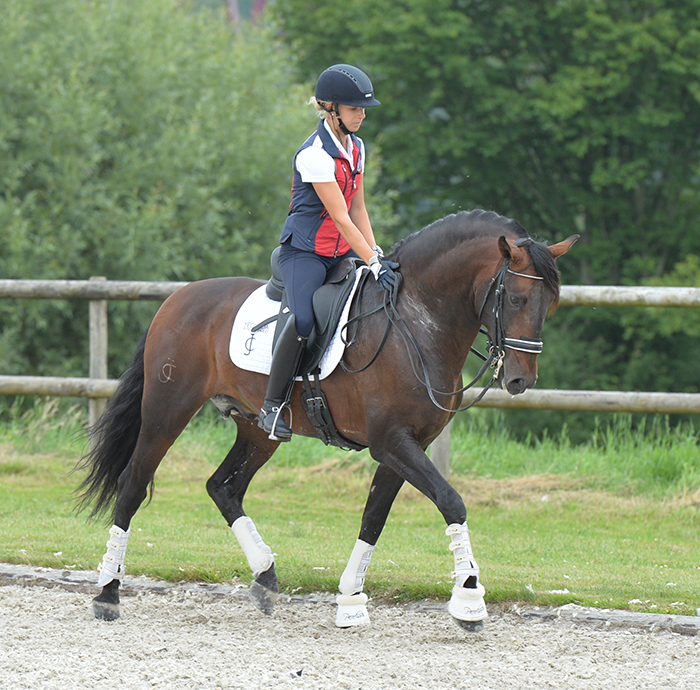
And at the horse show?
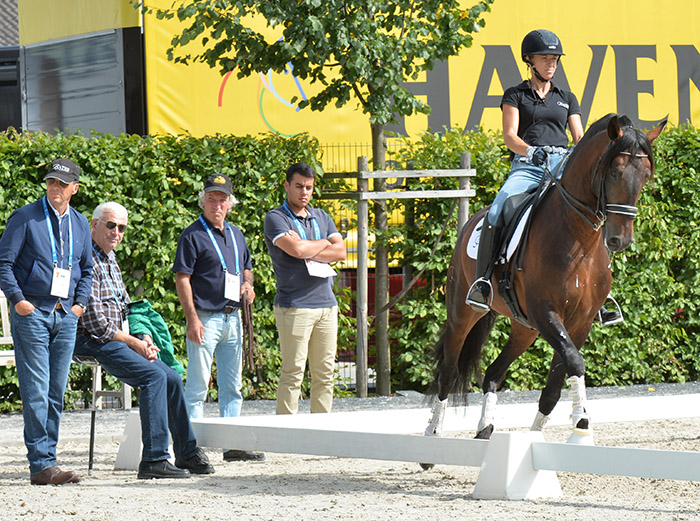
Maria Caetano – working with Ton de Ridder
How long have you been working with Ton?
“It’s coming now the second year. He was a long time friend. From the shows we knew each other. My father and I looked at his training, and it was very much like our way of training, equitation – dressage or equitation. Very classical and very respectful for the horses. Always respecting the balance of the Lusitano, that is also very important for us because we ride mostly Lusitanos. Sometimes I saw other trainers very strong and pushing too much the horses – and we like to respect the age and the stage of each horse, so Ton attracted us very much.”
“The first time we trained together, I felt like it was my father training, but adding much more experience from the shows. Ton is looking at every detail, which is very important. Because my father and I are working together on a daily basis, sometimes we forget those details but Ton is very strict with small details.”
“My father cannot come with me to every show and Ton will be there, and sometimes Ton comes to Portugal to see the evolution of the work. In the competition he is very positive and helps the mentality of the rider.”
Do you find it harder because you are showing Lusitano horses, and the judges are used to looking at Warmbloods?
“For me it is a pleasure to be able to show the horses from my country and to try to show them to the world of dressage because they are not so well known as the Warmbloods. In the beginning, like ten years ago, they were completely unknown, and they were strange for the judges’ eyes but now I think we are in a very good time for dressage judging. They judge on what they see, and if the horse is supple, and going well, then I think we can get the points we deserve.”
But you are riding quite a special type of Lusitano, you can still see in Portugal the very old type with not very good natural movement… You look for special lines?
“Yes. For example two of my horses are sons of Rubi, who was already a very successful horse in dressage. Of course I look for those special lines because we had a completely different selection in the past, bullfighting, working equitation, and now the breeders are trying to change a little bit, and I think they are doing very well especially as we have a very small number of mares compared to Warmbloods. I am lucky to have three Lusitanos who can compete internationally with the Warmbloods, and you can look at them, not as a traditional Lusitano, but as a sporthorse.”
But you never seem to get upset when you ride, when you came in with the young stallion, he was really jumping around, and you just sat, quiet…
“I know my three horses very well and I compete a lot abroad, and I know they are really excited with mares and with other horses, but that is just their way and in a few minutes, they will be working. It is not for me to get aggressive with the horses, that is not the way. We have to understand them and then step by step they relax, and they forget about the mares, and they know it is working time – but to fight them is not the way.”
Portuguese horses but the other essential is an Australian – Bates – Saddle…
“I was lucky the Spanish representative of Bates saw me riding at some shows, and asked me if I wanted to try – and I love the saddles. They fit very well to my horses, and Lusitanos in general. I am very proud to be sponsored by Bates.”
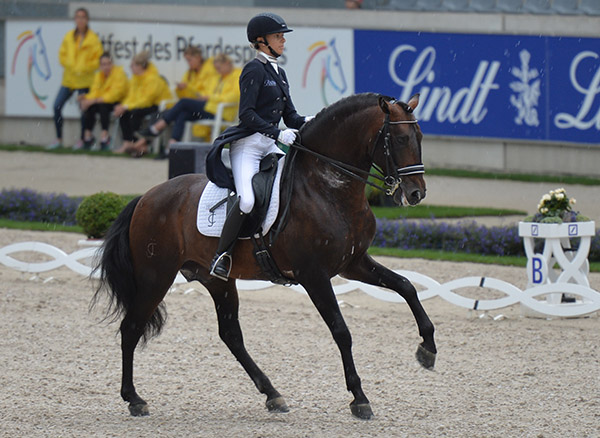
Ton de Ridder – From Eventer to Dressage Coach
Ton started his competition career as an eventer…
“I was at that time an eventer. Paul Stecken was very involved in Eventing – not a lot of his students got a chance to compete, but at that time, he bought a horse from the auction and I could ride that horse, and we built it up over three years, and I competed with this horse.”
Winning?
“Also yes.”
In the German team?
“No no, but I was not too bad. At that time around Münster there was a lot of eventing, famous riders like Horst Karsten – we were a big group together. At that time the courses were totally different and not so technical like we have now. For me, it was a great time!”
What was the next stage in your equestrian career?
“The next stage was when I got the opportunity to go to Dr Bauer who lives in the south of Germany. A very interesting, difficult, gentleman – at that time I think he was almost eighty. Paul Stecken sent me there and said, there you can learn a lot. Not always on riding, I will never forget it in my life – I learned that you have to be very strong, also to your employers, but still you have to respect the employers, and be to your employers, straight. And he was not every time, honest or straight. At a young age, you learn everything a little bit.”
“Then I had an awful accident on a cross country course. A little bit later, Martin Plewa saw me on course at an eventing competition, and he said, Ton what happened? You are not riding so forward any more, are you scared? I said, no I am not scared but I have a little bit respect. He said, then stop it, you can see it in your riding, you had a dreadful accident but you are young enough to find something else, so stop it.”
“Then, Paul Stecken again, he talked to Udo Lange, and I went there.”
What did you learn from Lange?
“To work very hard, to ride very precisely, never give up even when a horse has problems, always try something else – that’s the main thing.”
Had you started to ride dressage rather than eventing?
“I was doing medium level in dressage and young horse classes but then we went really to dressage.”
next Maria’s Grand Prix star
Case Study 3 – The Grand Prix Star – Coroado
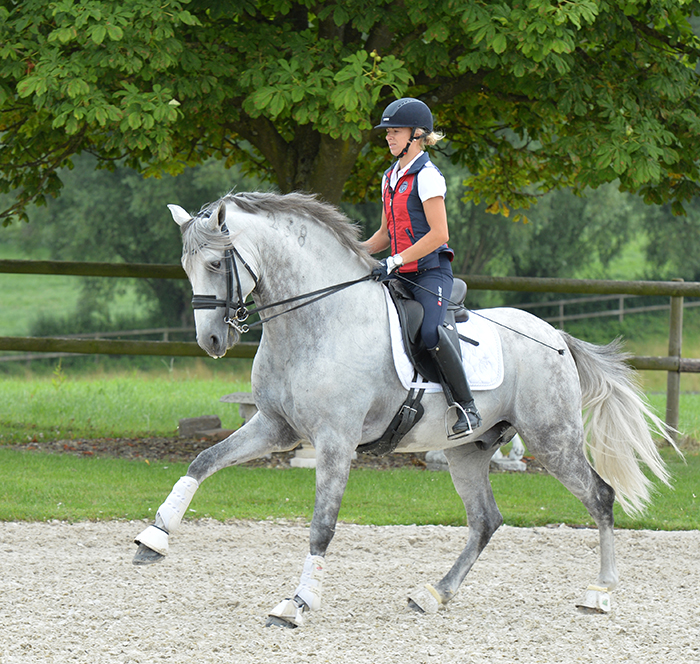
Time for the star now, Coroado, another by Rubi. Maria’s Grand Prix star and today we are fine-tuning the one times changes.
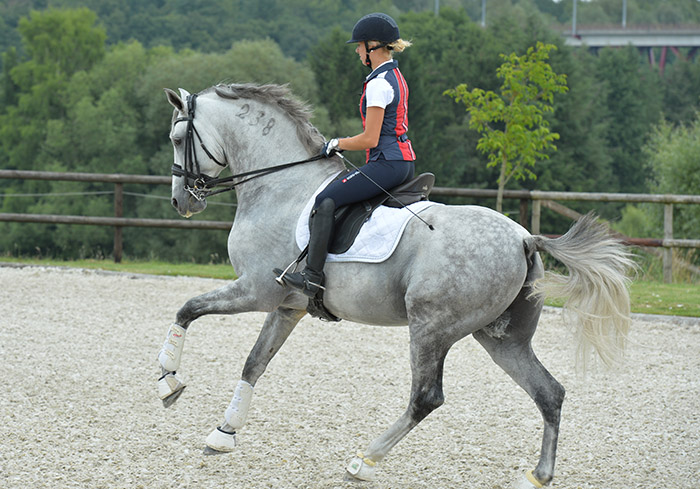
“You should feel good to do the one times changes. We don’t want to make a mistake, the horse doesn’t want to make a mistake, but don’t trust the horse in the changes, don’t believe that it will just happen, aids for every change. It’s going to be different in the arena, and you need to ride every change. After the ones do some twos, and open your leg at the last moment, and show the judges lightness, both hands forward, show the judges. And show the judges that after the half pass right, your horse is so supple he can immediately change to the left.”
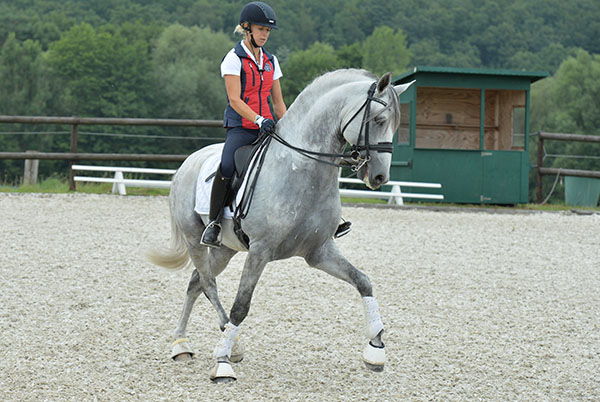
“With the extended trot to passage, take the activity to into the passage.”
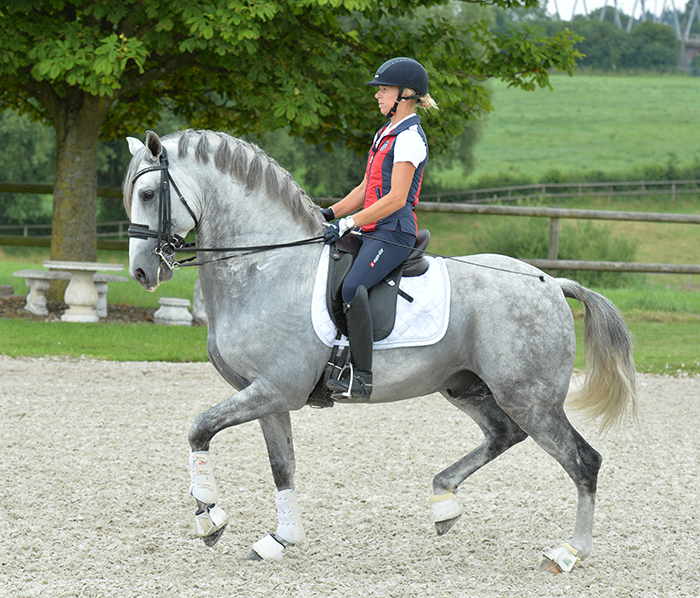
“Piaffe quicker, piaffe quicker, piaffe quicker, last steps the quickest. Stay in the piaffe, flex to the left, flex to the right, work in the piaffe.”
“Stop. It’s a long week, don’t make him tired. Loosen him, then one time to extended walk, now a loose trot down the centre line, let him know that the centre line is not always stress – piaffe / passage – that he can relax on the centre line.”
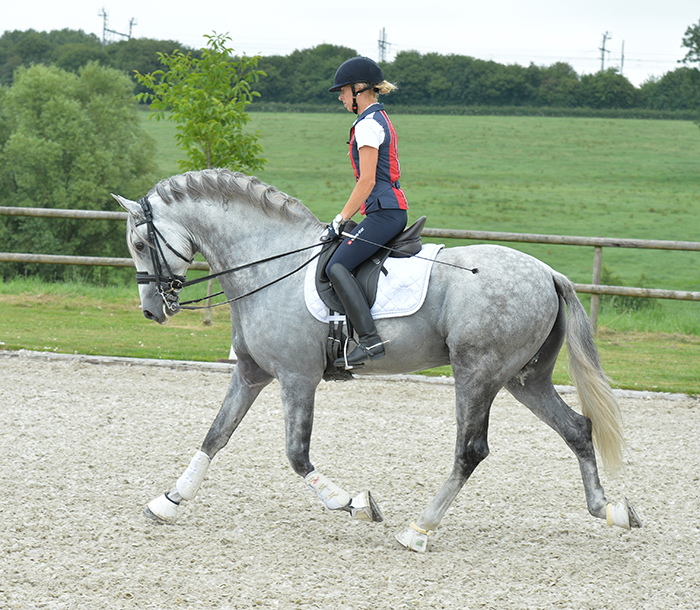
“Neck down in the transition to walk, extended walk doesn’t mean hurried – and make sure he is not behind the vertical in collected walk. In the extended walk, play with the contact on the snaffle rein, and then a clear transition to collected walk, with his nose on the vertical.”
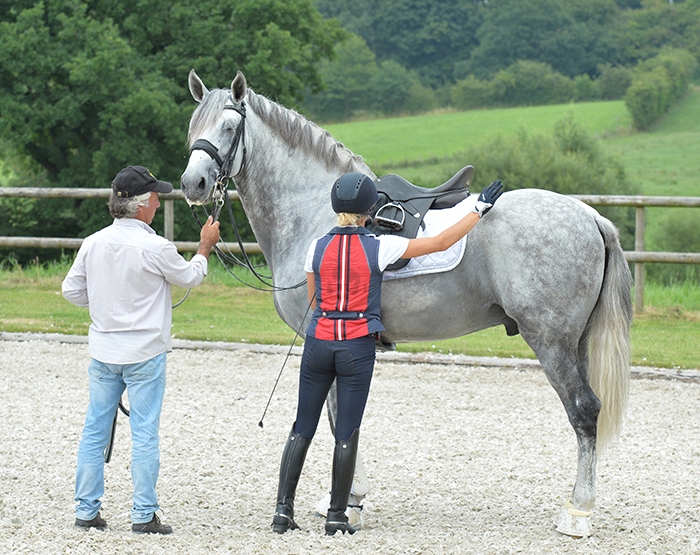
At Aachen, the pair starred and finished second in the 4* Grand Prix to another pupil of Ton’s Beatriz Ferrer-Salat.
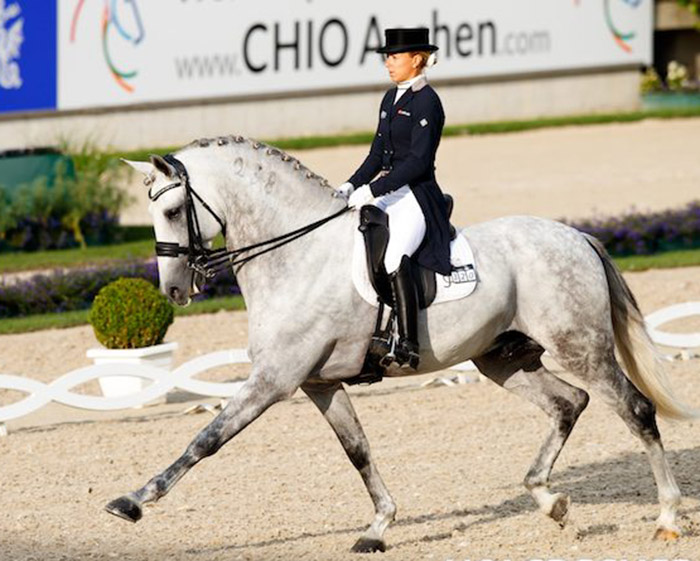
Ton de Ridder – Dressage Coach
Were you a good dressage rider?
“That I don’t know, you would have to ask other people. By my nerves, to be honest, I was not the best competitor. When I look to my wife, she had much better nerves than I had, and I am very lucky that my daughters have the nerves of their mother.”
Background: Ton’s wife, Alexandra is a super star in her own right, and competed at the Sydney Olympic Games on the beautiful Chacomo, and was part of the Gold medal winning German team.
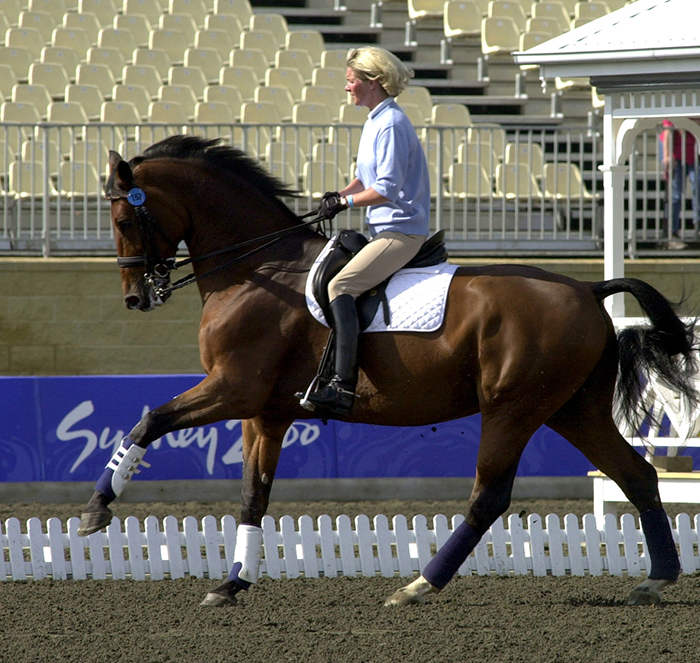
Alexandra and Chacomo were stars at the Sydney Games
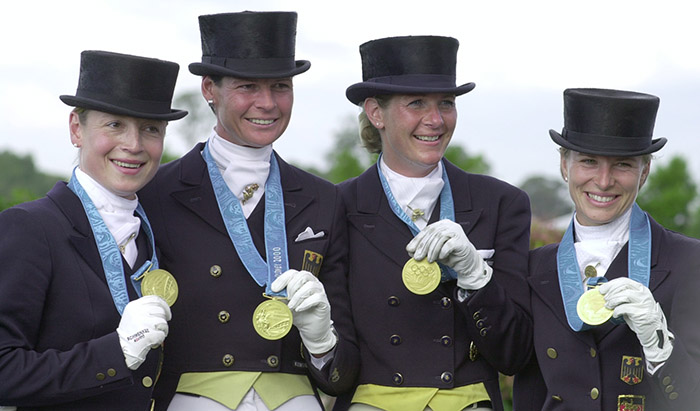
The German Gold Medal Team at the Sydney Games, Isabell Werth, Ulla Salzgeber, Alexandra Simons De Ridder and Nadine Capellmann
Did you ride Grand Prix?
“I did some small competitions with very young horses, Inter 2, and short Grand Prix. My wife and I moved to Aachen, and there we started with young horses. My job was to look after my wife, I worked for her father. We were a little bit unlucky, in a very short space of time, we lost three Grand Prix horses. One had poisoning, that was a little hard. We found some other horses for my wife to ride, but not horses for me. Perhaps I stopped too early, to be honest, but I trained a lot, did a lot of Young Riders, Juniors, and I was happy with that.”
When did Chacomo arrive?
“Chacomo I found at a farmer’s place. I saw him at twelve o’clock at night, a friend of mine, he’d also been at Paul Stecken’s, and he said Ton, I have to show you a horse, I think he is very interesting. I saw the horse free walking, and I will never forget, there was a jacket hanging next to the door, and the horse saw the jacket, he didn’t stop but his front legs came really up when he saw the jacket, and I said, wow, stop him, I want to buy him. I said to my friend, I want to buy this horse, and he said, it is not possible, I bought him for my wife as a birthday present. One year later, he called me and said Ton you must come quickly. Why? I cannot say it on the phone, but you have to come. I went there and he said, now you can buy Chacomo, my wife is pregnant. I said, you are the best stallion, you did a super job! So we bought Chacomo when he was almost four.”
Was Chacomo an instant success with your wife?
“We’d had some good horses before him, like Champus, but this horse was really special. He was always with the rider, never against the rider. He had a very good walk, very good trot, very expressive canter – at that time I think he had one of the best extensions in trot and canter. Good in passage, normal in piaffe, but he improved there. Alexandra and I were very lucky at the time, we had a lot of help from Jo Hinnemann, he gave us new inspiration, new ideas. Altogether with Johan, we were a really great team.”
And then you were very unlucky, you lost Chacomo not long after the Sydney Games…
“Yes. First he had a problem in his stomach, very difficult to explain, and afterwards, we found he had a lung tumour. But I think the main problem was the stomach, and a lot of cancer problems, like with people, come out of another problem. The main problem was the stomach, and that we found too late.”
You seem to have a special talent for stepping in with riders who are already well trained, like Beatriz Ferrer-Salat, who had spent time with the Theodorescus, and Jean Bemelmans, and it is the same with Maria Caetano, who is very well trained by her father – you seem to have some special skill at doing that final fine tuning…
“It’s a little bit the same as with my kids, you are looking every day, then someone else can bring in some new ideas. Every trainer has his special ideas, for me it is bending, flexion in the corner. Looking very closely before the competition that they are riding point to point – that I have learnt from all the time I have trained juniors and young riders here in Germany, and they get the points at the European championships, that they are really riding from point to point, collected trot is really collected, the medium trot ends exactly at the point with a nice soft transition. I think with Paulo Caetano it is very special, he trains his daughter, and I give my input, some ideas, some details, nothing special.”
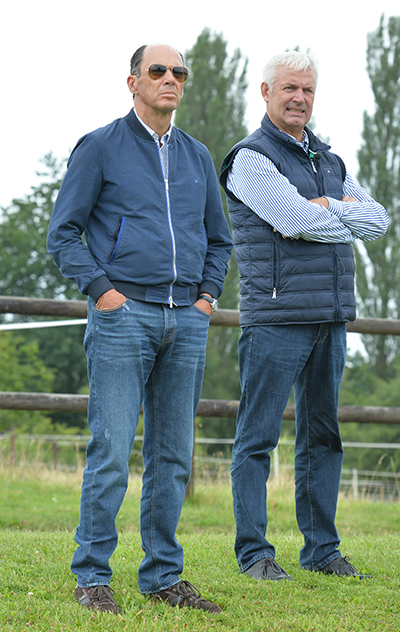
But there is nothing different – nothing ‘Portuguese’ about the way Paulo trains?
“Absolutely nothing different. For example, what you saw today when I worked with Maria, sometimes I am a little bit particular about the tempo, but that we discuss. Also to say very clearly, okay we are getting closer to Aachen, it is very special to ride a seven-year-old in the Prix St Georges and the Inter I, not only the breeding, but also the age of the horse, so we have to try very hard to take every point we can.”
You are even thinking about where a transition or a rein back, is in relation to the gate and the horses in the warmup arena…
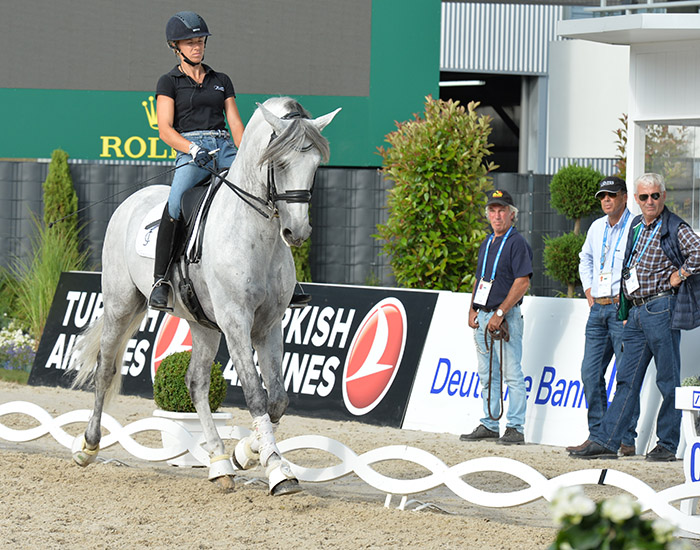
“Yes – a good teacher should not only teach, he should be a little bit like a manager, and I know after all the years I was visiting Aachen, training in Aachen, that the arena is very special, especially on the short side where you know the horse can look at the horses warming up arena, when you come from the left hand side, sometimes there is a little bit of noise at the back of the horse and I try to make the riders as strong as possible in their mind, to put the horse in a little bit shoulder in position, to keep him busy so he is not looking at the warming up arena. This is part of the trainer’s job.”
And it is part of your job as a trainer to work with the rider’s mind?
“Yes, to get them ready on the day and make them strong. Like what we did today, specially with the St Georges, four tempi from the left, three tempi from the right, then also two tempi, transition collected canter, collected trot, you can get there a lot of points.”
Do you talk to them much when you get into the competition situation?
“No, they are already prepared, which means we have spoken about the special details of this arena and it is not necessary to say this in the last moment, and they don’t understand it, and everybody gets upset. I think preparing for the competition, everybody has to be so quiet – the mind of the rider has to be really prepared, not trying to start in the last moment.”
Do you have to work very hard to give them a positive message?
“You can be positive about the competition, but you should not lie. We had a little bit of an accident at Munich with Maria’s Grand Prix horse. She was going from the stables to the warming up, when there came a lot of polo horses, the riders were a little wild and Maria’s horse jumped around, and he hurt himself a little bit. In the beginning, I thought the horse was sound, but you have to be honest, and in the test, the horse was not sound, so we stopped after the Grand Prix. Still all the team has to be quiet and not yelling and make everyone nervous. We say shit happens, and that was a really unlucky moment. With the other horse, the seven-year-old in Munich, everything was perfect, second in the St Georges and he wins the Inter I, that’s pretty good.”
Is it harder for Maria riding Lusitanos? These horses are very natural movers but they still look different from a German warmblood…
“Yes, but you saw what we did today, with horses with this breeding, you have to give attention to the good position of the neck, you have to show the things they can do, and be very accurate to get every point you can.”
Now you are closing down the stables next to your house – the end of an era?
“It was a very interesting period, a very hard period, also a very successful period, but there have been a lot of developments around our property, they were getting closer and closer, and my parents-in-law have a beautiful property in Belgium and we want to concentrate more on one spot, one place, Alexandra and I, we get a little bit older and sometimes we need a little bit of free time. The last few years, we worked almost seven days a week. Okay we want to do the training a little bit better, more concentrated and not with that many people any more.”
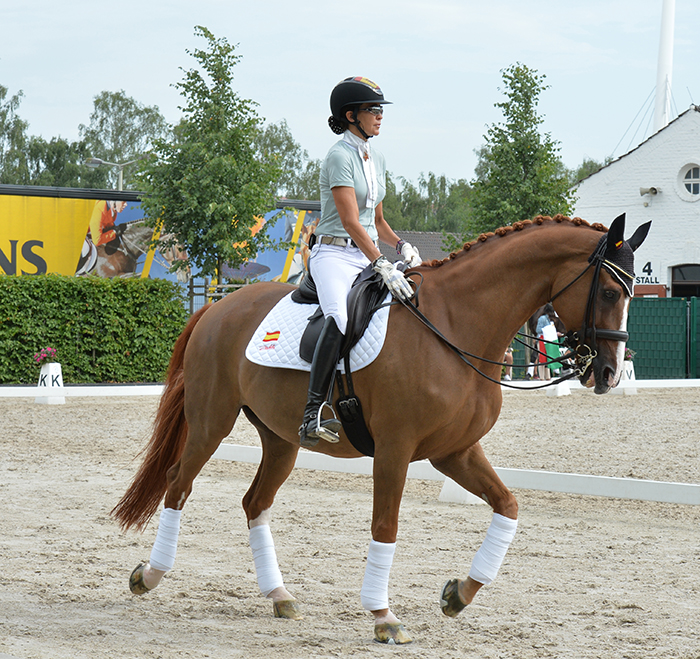
Beatriz and Delgado at Aachen
Beatriz Ferrer-Salat is one of those good clients, You have trained with some wonderful trainers, what does Ton add?
“For me the most important thing is that Ton gives you a lot of confidence and he supports you. It doesn’t matter what happens, you know he is supporting you and that is amazing for me. I’ve had pretty good trainers, and sometimes when there are problems, they just leave you there. Ton’s support is really great.”
“He’s very good technically. You can have a discussion with him, I think this is better like this, and he explains why he thinks it is better like that, there is always a dialogue. He is a perfectionist and he pushes a horse, but not too much. He pushes it to the right point, I think.”
The final words from the man himself:
What is the future for Ton de Ridder?
“My future will not change a lot. I get now a little bit older. I have already for a long time, grey hairs, and get now a little bit more quiet – and try to enjoy life more, not only at the horse competitions. I still have very nice, very good clients and we will continue.”
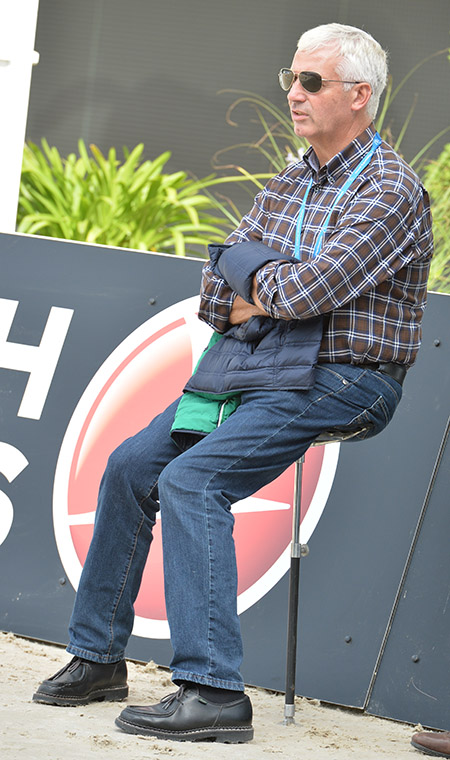
A note on the breeding of Maria’s horses:
Two of Maria’s horses are by Rubi (Batial / Xaquio CIP). Rubi was ridden at the London Games by Goncalo Carvalho, and he looked great, finishing 13th in the Special to go all the way into the Freestyle.
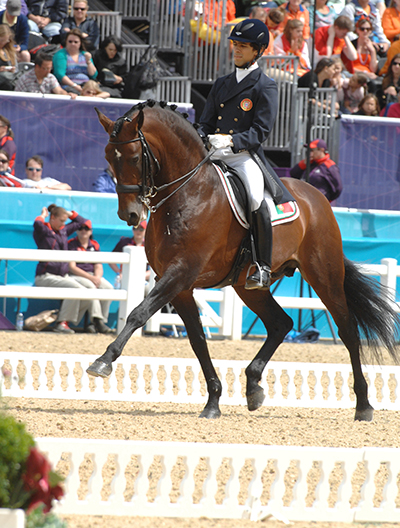
Rubi at the London Games
I asked Maria – Do you find it harder because you are showing Lusitano horses, and the judges are used to looking at Warmbloods?
“For me it is a pleasure to be able to show the horses from my country and to try to show them to the world of dressage because they are not so well known as the Warmbloods. In the beginning, like ten years ago, they were completely unknown, and they were strange for the judges’ eyes, but now I think we are in a very good time for dressage judging. They judge on what they see, and if the horse is supple, and going well, then I think we can get the points we deserve.”
But you are riding quite a special type of Lusitano, you can still see in Portugal the very old type with not very good natural movement… You look for special lines?
“Yes. For example two of my horses are sons of Rubi, who was already a very successful horse in dressage. Of course I look for those special lines because we had a completely different selection in the past, bullfighting, working equitation, and now the breeders are trying to change a little bit, and I think they are doing very well especially as we have a very small number of mares compared to Warmbloods. I am lucky to have three Lusitanos who can compete internationally with the Warmbloods, and you can look at them, not as a traditional Lusitano, but as a sporthorse.”
It turns out that Maria doesn’t just ride these new dressage style Lusitanos, her father, Paulo is one of Portugal’s most famous bull-fighting riders and has been instrumental in the development of the breed.
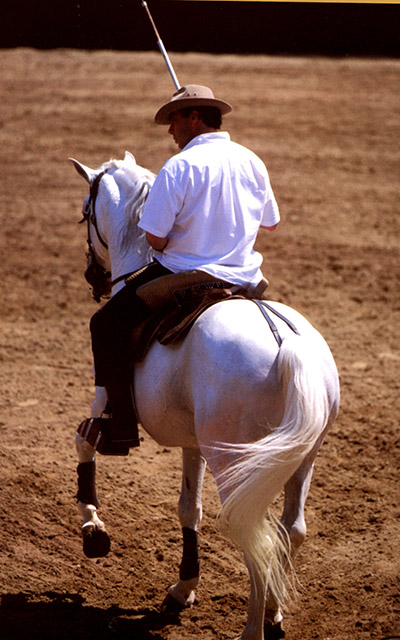
“I started breeding horses in the 1975. I was already a rider, a young rider, but I started very early. My uncle was a rider and bred horses and then I started by myself. I started by buying, in my opinion, some of the best mares Portugal had at that time. They were bull-fighting mares, Lusitano mares, but they were mares with the kind of movement that I looked for. The most important of these mares, and of all the horses of this time, was Quieta. I bought her when she was six years old. She gave three very important sons – Xaquiro, Altivo and Capote.”
“Altivo was a fantastic horse, he could canter doing one tempi changes towards the bull, twenty flying changes and then relax perfectly. He had such nice movement, swing in the trot, he already was a dressage horse. So I started to breed with him – nowadays his genetics are still in dressage, for example his son Altaneiro is one of the best Grand Prix Lusitano horses competing in Spain. Then there was another son, Capote – he was bigger, with more ‘blood’. I sold this horse to a very important breeder in Portugal – José Manuel de Mello. Altivo gave also another important son, Jalisco, who went on to the Grand Prix champion of dressage in Belgium. He was one the first Lusitanos to make a real name in dressage. Everything came from Quieta, she was big for a Lusitano in those times. Super swing, a ground covering canter.”
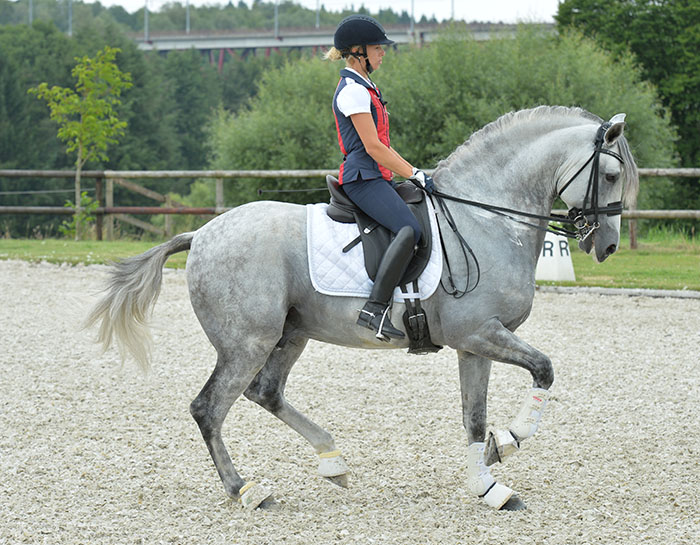
If we look at Maria’s Grand Prix stallion, Coroado, he is by Rubi, whose dam sire is Xaquiro – out of Luxelia, who is by Xaquiro.
“My beginnings were with a classic master – Viconde da Corte – and he would always talk about the quality of the movement and the lightness of the horse, and that is why I chose this mare. This is the basis of my breed, and the basis of nearly all good dressage horses in Portugal.”
When did your goal change from breeding horses for bullfighting to breeding horses for dressage competition?
“I have to say that it is not so different, because the capacity for collection, flexibility, the capacity to get energetic, and at the same time relaxed. I never looked for the Baroque horse, I always looked for Lusitanos that were a little bit stronger and more powerful, I think because my Master was more close to dressage than bullfighting.”
“It’s fantastic, now we have three or four bloodlines to work with, not so many horses, but it is working, we are making horses that can compete.”
Were you tempted to follow the example of the Frenchman, Sylvain Massa of the Elevage Massa, to cross Trakehner stallions over Lusitano mares – some of the horses he bred are now doing quite well at Grand Prix….
“I think it can be a good idea but I have to wait and see, because it is easier to work with the genetic that we know very well and manage, then when we start to work with a genetic that we don’t know so well, we have to be careful – but I must admit, I think it’s a good idea. Maybe it is a long term project, not a short term project, but a good idea.”
You are still breeding?
“I am, and right now I have two young horses that I think can become very good Grand Prix horses, we shall see.”
Fürstenball, beautiful, black and producing winning progeny – contact International Horse Breeders for more information: www.ihb.com.au
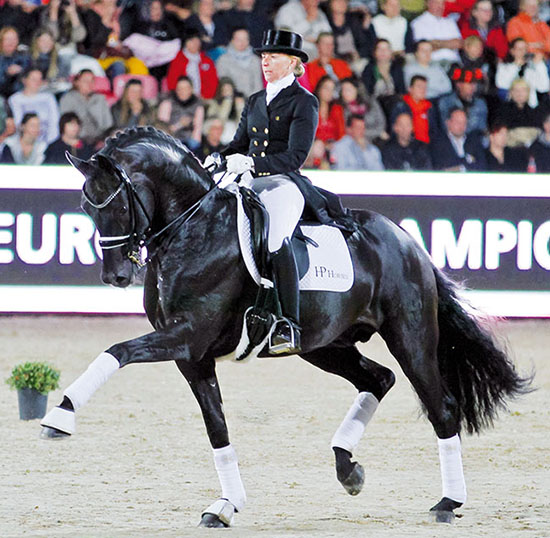
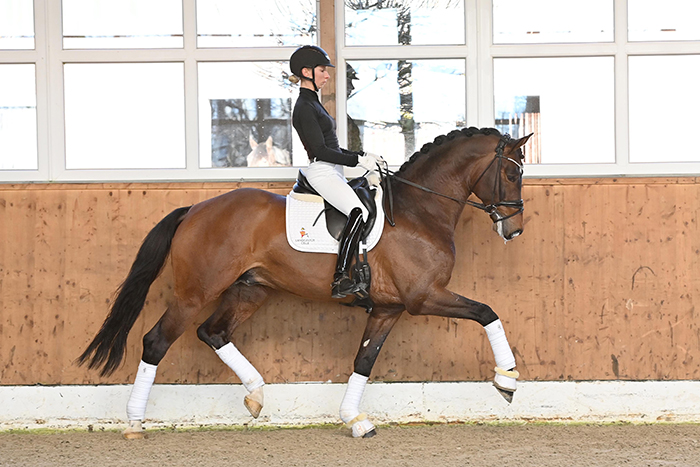
And Fusionist, combining the best Dutch and Hanoverian bloodlines


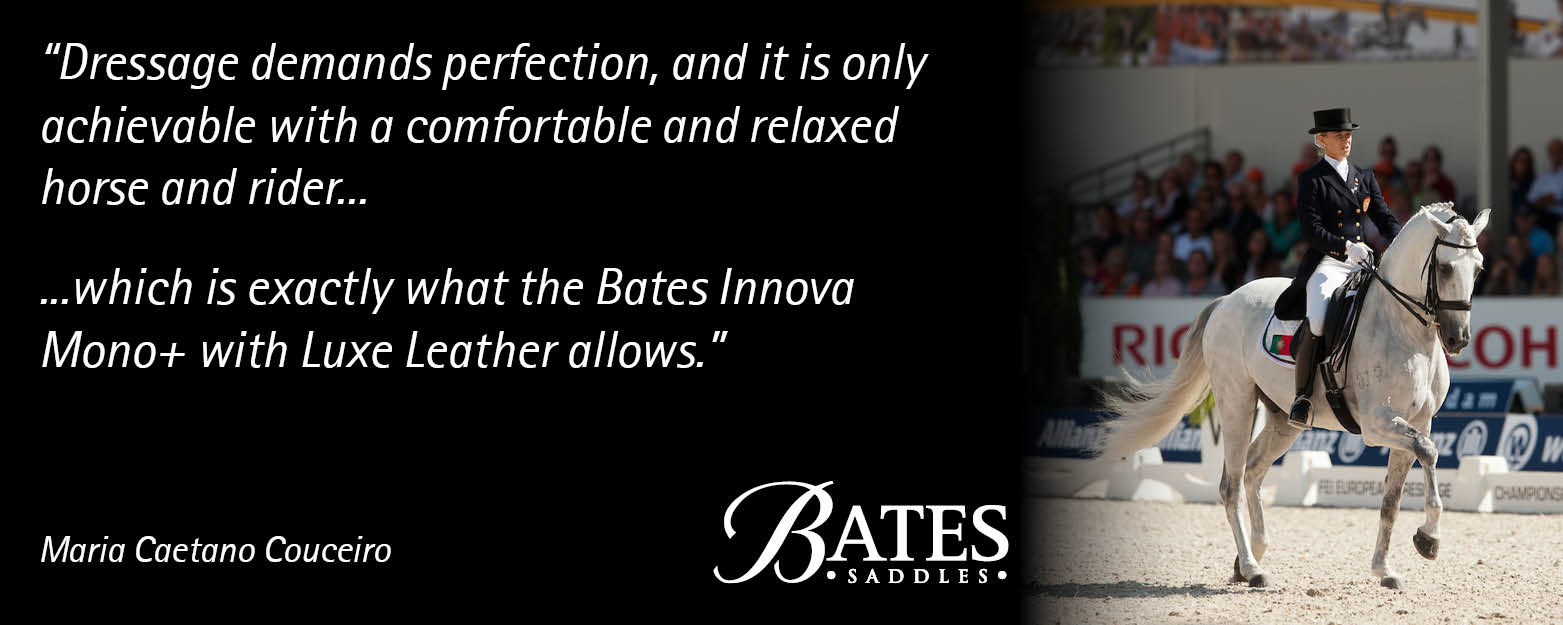
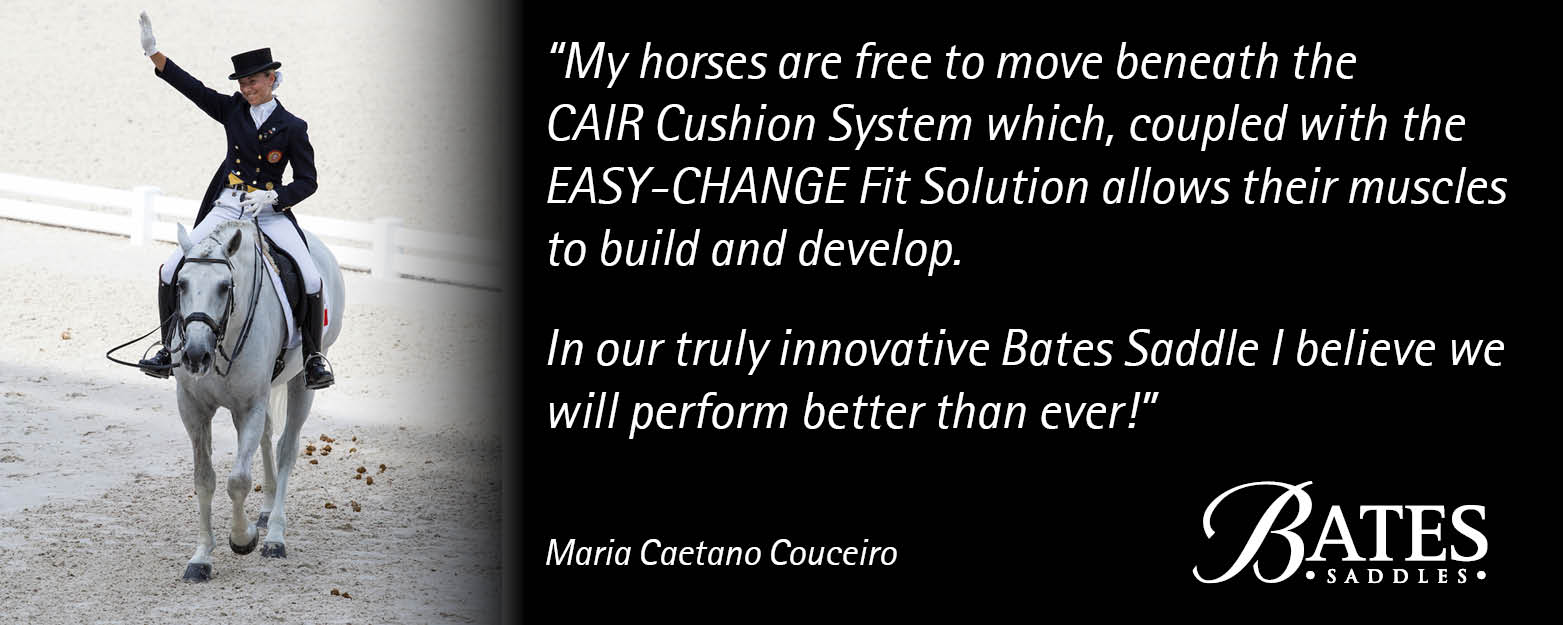
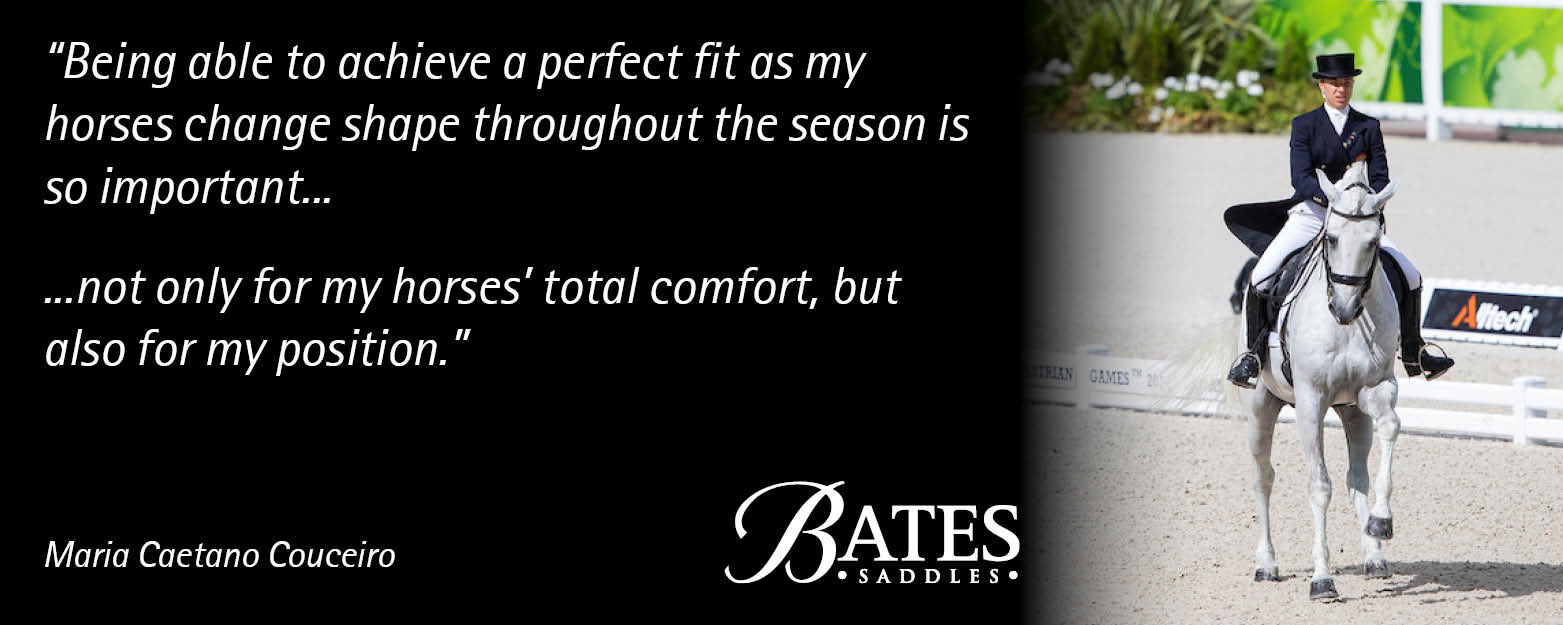
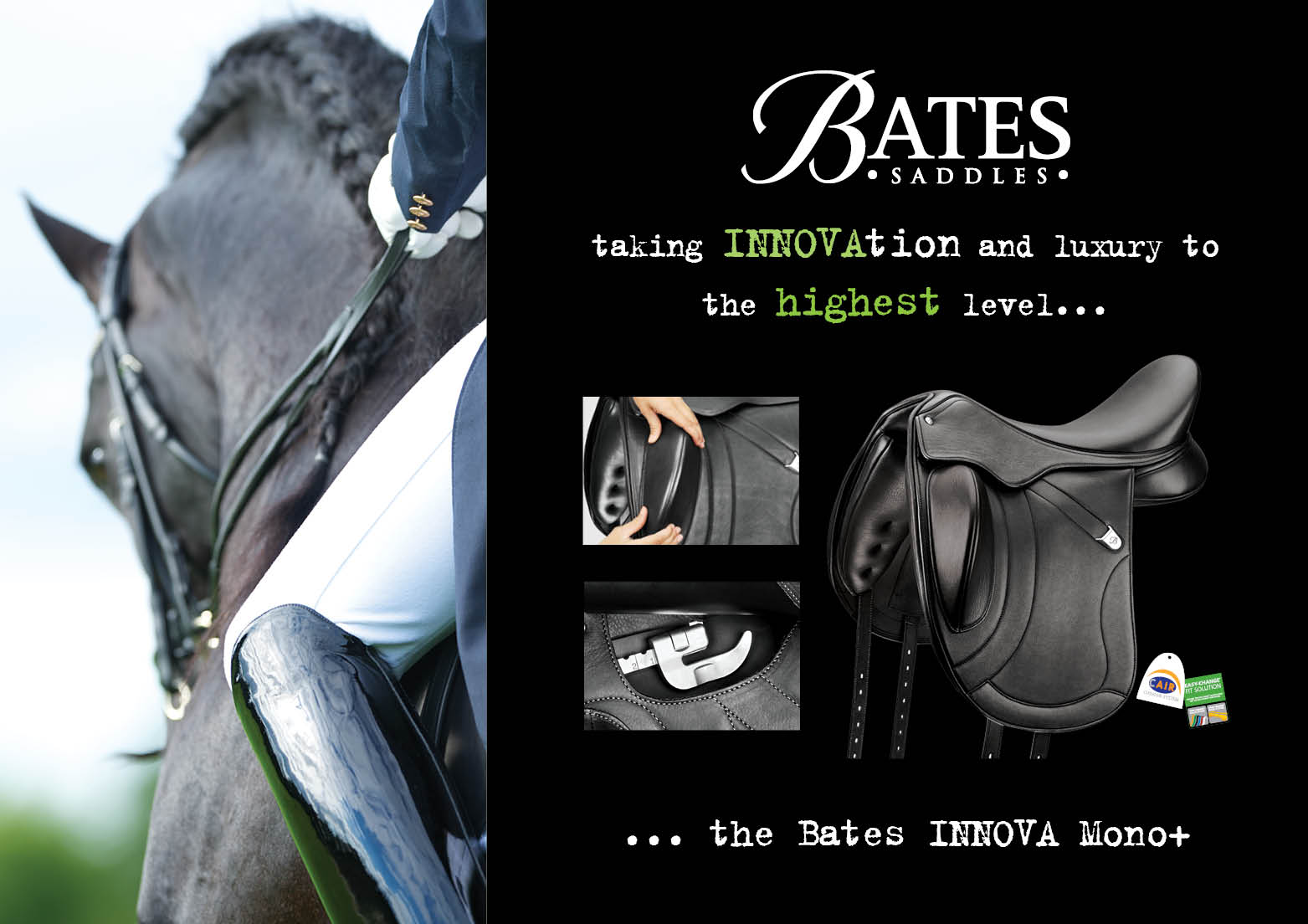
Brilliant…..wish more riders would take note
i’m sure I enjoyed riding my half Andalusian horse the most of all I competed on, even Charisma didn’t give me such a great feeling. But in those days the judges didn’t always enjoy him so much…..
This is great! All riders should read this!